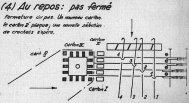- Home
- Resurrection ▾
-
Learn ▾
- Free library
- Glossary
- Documents
- Initiation
-
Shaped fabrics
- Introduction
- Popularization
- Definitions
- Le métier de façonné
- Principes du façonné
- Mécaniques de façonné
- Le jeu des crochets
- Les cartons
- Chaîne des cartons
- Mécanique 104 en détail
- Pour en finir
- Montage façonné
- Empoutage 1/3
- Empoutage 2/3
- Empoutage 3/3
- Punching, hanging and dip
- Autres façonnés
- Façonnés et Islam
-
Cours de tissage 1912
- Bâti d'un métier
- Le rouleau arrière
- Les bascules
- Formation du pas
- Position de organes
- Mécanique 104 Jacquard
- Fonctionnement 104
- Lisage des cartons
- Le battant du métier
- Le régulateur
- Réduction et régulateur
- Mise au métier d'une chaîne
- Mise en route du métier
- Navettes à soie
- Battage
- Ourdissage mécanique
- Préparation chaînes et trames
- Equipment ▾
- Chronicles ▾
- Fabrics ▾
- Techniques ▾
- Culture ▾
- Language ▾
Lorsqu'on a passé la navette et relaché complètement la marche (pédale)


A la fin de la course de la marche (pédale) lorsqu'on l'enfonce
Durant la course de la marche (pédale) lorsqu'on l'enfonce
Avant d'appuyer sur la marche (pédale) qui commande la mécanique
The Jacquard (and Vincenzi) cartons are assembled by bonding together in the form of an endless chain which is usually called a sleeve when there are few cartons and work to execute an armored pattern and drawing when they are numerous and Work to perform a complicated figurative motif.
Each of the boxes indicates the hooks and wires that must be lifted or not for a cut.
So if a drawing should measure 10 cm high on a fabric with 24 picks (frames) per cm, it will be entirely woven when we have passed 240 frames. At that time, 240 boxes of Jacquard were passed.
Since this chain of cartons (sleeve or drawing) is endless, after the last cardboard (the 240th), the first cardboard will appear again to attack a second pattern identical to the first one.
The endless chain of cardboard is threaded on a mechanical part of which we have not yet spoken.This piece called cylinder is in fact a four-sided block of wood, each of which is pierced with as many holes as the mechanism has of hook / needle pairs. The position of these holes corresponds, of course, to the output of the ends of the needles in the needle plate, against which the cylinder will press the cartons. So that each needle is in front of a hole in the cylinder.
We will now see how the boxes select the hooks on each frame cut:
Since a cardboard will be positioned between a face of the cylinder and the end of the needles, the needles will be pushed back where there is no hole on the cardboard, and instead remain motionless where there is a hole in the cardboard.
This is what we can observe on the four sketches below, which show what is happening:
Cardboards



